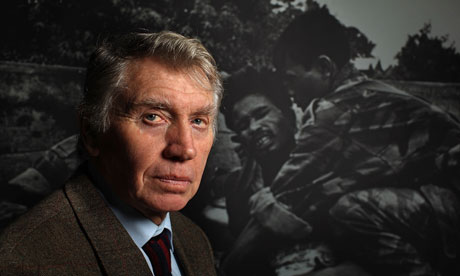A life in photography: Don McCullin
I saw 800 children dropping down dead in front of me. That turned me away from the gung-ho image of the war photographer
The Guardian,

A few years ago Don McCullin, inevitably on assignment in a geopolitical hotspot, found himself hors de combat in a dusty and ill-equipped local hospital. He had a broken rib and a collapsed lung and woke up, the morning after sustaining his injuries, to be confronted "through a haze of pain and medication" by the sight of ministry of the interior policemen standing at the foot of his bed. "And of course they wanted my passport," he recalls. "Which was, of course, full of some pretty exotic stamps. Here we go, I thought. This could be fun."
Had McCullin, the great war photographer, been felled by a Vietnamese bullet or Israeli shrapnel? By Congolese thugs or Belfast paramilitaries? In fact, none of the above. For although he was in Syria, he wasn't there to chase war or discord, or at least none that had occurred within the last couple of millennia. Instead, he had been photographing the Roman ruins at the Great Sanctuary of Bel in Palmyra as part of a wider project to document the frontiers of the Roman empire. And the now septuagenarian photographer had simply tripped over some fallen masonry.
"I came round in the hospital and a rather attractive translator from my hotel explained that the police weren't even really interested in me. They just wanted to know if anyone had given me a push so they could go out and crack someone's skull. That's the flip side of a police state," he laughs. "Sometimes they can have your interests at heart. And to be fair to them, I felt less under surveillance in Syria than I do in England. Every street in London has a camera, and if you ever travel up the M4 it feels as if George Orwell should be your chauffeur."
McCullin will be discussing the fruits of his work in Syria, as well as elsewhere in the Levant and the Maghreb, on Friday at one of the early events at this year's Guardian Hay festival. His latest book, Southern Frontiers marks the culmination of three years' work for a man better known for recording more contemporary imperial adventures. The project had its genesis in the 1970s when McCullin was on assignment with Bruce Chatwin to report on the harassment by French fascists of Algerian refugees in Marseilles. "One night we just got the ferry over to Algiers to follow it up and there I got my first glimpses of these remarkable structures which have stayed with me ever since." He has now returned in the spirit of the Victorian painters and early photographers of the late 19th century such as David Roberts and Francis Frith to capture the ruined temples, theatres, colonnades and statues that marked the far corners of Roman expansion.
"Yes, it's a departure", he acknowledges. "But there is also more of a link than you might think to my previous work. I was absolutely overjoyed to be in these remarkable spaces. You feel part of the great canvas of history. But it is difficult to avoid the vibrations of the cries of the people who built them more than 2,000 years ago. The energy it took to put them up would have cost thousands of lives, and people must have perished left, right and centre. They are huge statements and wonderful achievements. But achievement is one thing and cost is another."
The cost to ordinary people of decisions made by their rulers has been at the heart of McCullin's work since he made his name with photographs on the construction of the Berlin Wall before moving on to produce legendary images from the war zones of Indochina, Latin America and the Middle East. After seeing his work, Henri Cartier-Bresson said to McCullin: "I have one word to say to you: Goya." An admiring John le Carré, with whom McCullin visited Beirut, wrote in an introduction to McCullin's 1980 book, Hearts of Darkness: "He has known all forms of fear, he's an expert in it. He has come back from God knows how many brinks, all different. His experience in a Ugandan prison alone would be enough to unhinge another man – like myself, as a matter of fact – for good."
"I've seen my own blood and broken a few bones," says McCullin, "I've been hit, which isn't an entirely bad thing as at least you have a glimpse of the suffering endured by the people you are photographing. And in a sense, crumbling empires and war have been with me all my life. I'm from England, and like every other great empire who stole bits of the world, there is a price to pay. And I was born in 1935. So since I've been conscious of the world I've either been in, or been on the periphery of, a war zone."
The above is an extract of the article that appeared in The Guardian. To read the whole piece follow this link (you may need to cut and paste it into your browser window).
http://www.guardian.co.uk/culture/2010/may/22/don-mccullin-southern-frontiers-interview
further to this article you may find the follow piece, also from the Guardian website, another interesting view of the influence and outcomes of war and combat photography.
Link to Marlboro Soldier article
And another view of the same image by the photographer that took the image can be found on the LA Times website Here
And a follow up article in the Guardian/Observer Here
Are we spoiling you or what?

No comments:
Post a Comment